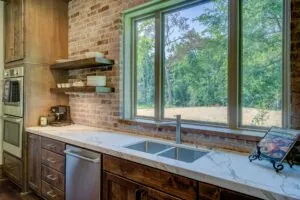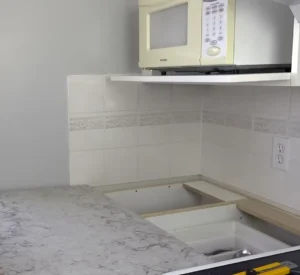Are you thinking about giving your bathroom a fresh look but don’t know where to start? You’re not alone. Many homeowners struggle with planning and executing a bathroom remodel that balances style, function, and budget.
Did you know that bathrooms are more popular for remodeling projects than kitchens? They often require less time and money due to their smaller size.
This blog will guide you through essential considerations like design choices, innovative layouts, proper lighting, and fixture upgrades. We’ll share expert advice on how to avoid common mistakes and make the most out of your project.
Ready for some Bathroom Renovation Tips? Read on!
Key Takeaways
- Choose durable, waterproof materials like ceramic tiles or luxury vinyl plank for bathroom flooring to withstand moisture and heavy foot traffic.
- Lighter colors such as soft blues and off-whites can make small bathrooms feel larger by reflecting more light and creating an airy atmosphere.
- Proper ventilation is crucial; installing a high-quality exhaust fan can prevent mold growth and maintain good indoor air quality.
- Utilize hidden storage solutions like recessed shelves or niches in shower walls to save space while maintaining an elegant look.
- Modern fixtures such as low-flow showerheads and tall toilets improve efficiency, reduce water usage, and enhance the bathroom’s aesthetics.
Essential Design Considerations
Choosing the right materials can greatly impact your bathroom’s functionality. Opt for designs and colors that make the space feel larger and more inviting.
Choosing the Right Flooring
Bathrooms endure significant foot traffic and moisture. Opt for durable, waterproof materials like ceramic and porcelain tiles or luxury vinyl plank. These options withstand wear and offer numerous design possibilities.
If aiming for a touch of elegance, stone flooring can create a luxurious feel but be cautious about its slippery nature when wet.
Grout lines and tile patterns are crucial in bathroom spaces. Using small tiles with more grout provides better grip, reducing the risk of slips. Stick to neutral colors to maintain versatility in your design choices, making future updates easier without needing another full remodel.
Choosing the right flooring affects both functionality and aesthetics, says interior designer Jane Roberts.
Also, consider sheet vinyl as an affordable yet effective alternative that offers excellent water resistance. This material mimics pricier surfaces while providing a softer underfoot experience—ideal for homes with children or elderly members prioritizing comfort alongside style.
Selecting Color to Enhance Room Size
Lighter colors can create an illusion of more space in a small bathroom. Choosing pale shades like soft blues, light grays, and off-whites makes the area feel open and airy. These colors reflect more light, brightening the room and making it appear larger than it is.
A strategic color palette sets the foundation for your bathroom’s aesthetic. Opt for consistent hues on walls, tiles, and even shower doors to maintain visual harmony. This unifying effect prevents visual clutter and contributes to a sense of spaciousness.
Incorporating mirrors amplifies this effect since they bounce light around the room, enhancing brightness. Combining these lighter shades with solid surface materials can further streamline your design while maintaining a clean look throughout the bath area.
Effective Bathroom Ventilation
Proper bathroom ventilation is crucial for maintaining a healthy environment. Installing a high-quality exhaust fan ensures the removal of excess moisture and odors. This prevents mold growth, which can damage fixtures and surfaces, extending their lifespan.
Without proper ventilation, bathrooms often suffer from poor indoor air quality, posing potential health risks to your family.
Adequate ventilation also improves water efficiency by preventing the dampness that leads to unnecessary water usage in cleaning efforts. Consider placing exhaust fans near showers or tubs where humidity levels are highest.
Windows can be an additional source of effective airflow if well-positioned. Make sure the venting system directs moist air outside rather than into attics or other parts of your home, ensuring it doesn’t become trapped elsewhere and cause problems down the line.
Innovative Layout and Storage Solutions
Ever thought about hidden storage in your bathroom? Imagine sleek cabinets that blend into the walls, giving you extra room without cluttering the space.
Building Niches and Recesses for Extra Space
Building niches and recesses in your bathroom can save space and add style. These practical additions are perfect for small bathrooms.
- Shower Nook: Create a recessed shelf in the shower wall. This area can store shampoos, soaps, and other bath essentials without eating up floor space.
- Built-in Shelves: Install shelves into the walls instead of using bulky cabinets. They provide storage for towels, toiletries, and decorative items.
- Toilet Cabinet: Place a small cabinet above the toilet. This often overlooked spot is ideal for holding extra toilet paper and cleaning supplies.
- Medicine Cabinet Recessed into Wall: A recessed medicine cabinet keeps your countertop clutter-free while offering easy access to daily necessities like toothbrushes and medications.
- Corners Recessed Shelving: Use corners creatively by carving out shelves for a unique storage solution that doesn’t intrude on your bathroom’s walkways.
- Vanity Niches: Cut out sections of drywall over or beside the vanity for built-in compartmentalized storage of grooming supplies.
- Bathtub Alcove: Build niches around the bathtub area to hold bath oils, candles, and other relaxing elements within arm’s reach without occupying additional room.
- Entryway Storage Recesses: Near the door, create small compartments to keep things like spare rolls of toilet paper or cleaning tools hidden yet accessible.
Using these niches will maximize every inch of available space while maintaining an elegant look in your bathroom remodel project.
Freestanding Pieces for Flexibility
Freestanding pieces like decorative chairs or cupboards can revolutionize your bathroom’s functionality and design. They offer flexibility in layout, making it easier to alter the space without drastic changes.
For instance, adding a freestanding cupboard provides ample storage while keeping essential items within easy reach. This approach also allows for creativity in placement; move the pieces around until you find the perfect fit.
Swapping locations of rooms can maximize available space too. Consider placing your laundry room where your bathroom was or vice versa for better utilization of square footage. Combining two small rooms into one larger area creates a more spacious environment, ideal for families needing extra elbow room.
Slimmer sinks open up floor space significantly compared to full vanities. Opting out of bulky, built-in fixtures lets you play with different layouts and styles as needed over time.
A vessel sink paired with a narrow counter adds both elegance and practicality to smaller bathrooms without compromising on style.
Creative Placement of Mirrors and Hooks
Mirrors and hooks can transform your bathroom into a more functional and stylish space. Clever placement not only maximizes utility but also enhances the room’s appearance.
- Utilize Corners: Mount mirrors in corners to reflect light and create an illusion of more space. This trick works wonders in small bathrooms.
- Above The Sink: Place a mirror above the sink to brighten up your grooming area. Opt for floor-to-ceiling mirrors to make the room feel larger.
- Opposite Windows: Position mirrors opposite windows to bounce natural light around the room, making it feel airy and bright.
- Decorative Hooks Near the Shower: Install decorative hooks close to the shower for easy access to towels, robes, or bath sponges, maximizing convenience.
- Back of Doors: Use hooks on the back of bathroom doors for hanging robes or outfits, utilizing otherwise wasted space efficiently.
- Hooks Beside Vanities: Fix hooks beside vanities for quick reach of hairdryers or other grooming tools, keeping counters uncluttered.
- Over Bathtub Edges: Hang mirrors over bathtub edges at an angle to enhance relaxation areas with better lighting and a sense of depth.
- Hallway Mirrors Near Entries: Place large hallway mirrors near bathroom entries to give an impression of continuity and expand perceived space.
- Layered Mirrors with Hooks Combination: Combine layered mirrors with strategically placed hooks beneath them for both aesthetics and added functionality.
- Mirrored Storage Cabinets: Integrate mirrored storage cabinets along walls, providing both reflective surfaces and hidden storage solutions.
Strategically using these tips will help make every inch count while adding style points to your bathroom renovation project!
Lighting and Accessibility
Proper lighting and easy access make a bathroom both functional and welcoming.
Importance of Natural and Artificial Lighting
Natural and artificial lighting play crucial roles in bathroom renovations. Incorporating natural light through skylights, windows, or frosted glass panels can brighten the space and create a welcoming atmosphere.
Using translucent materials for walls allows more sunlight to seep into the room, enhancing its overall aesthetic while cutting down on energy costs.
Artificial lighting also matters greatly. Implementing dimmer switches gives you control over the brightness, setting a spa-like ambiance for relaxation. Proper illumination around mirrors ensures better visibility for tasks like shaving or applying makeup.
This blend of natural and artificial elements creates a functional yet stylish bathroom environment perfect for any renovation project.
Ensuring Easy Access and Movement
Wider pocket doors make a big difference for wheelchair access, especially for those with mobility issues like a disabled grandma. This ensures she can move through the bathroom easily without bumping into barriers.
Installing grab-bar support aids next to toilets and in showers offers extra safety and stability.
Consider using pedestal sinks instead of cabinets to create more leg room. Pedestal sinks allow wheelchairs to roll up close, which makes handwashing easier. Adding a sliding shower chair helps people who can’t stand long or need help bathing.
The chair slides smoothly on rails, so they don’t have to step over high bathtub edges.
Setting the toilet at an appropriate height is crucial too. A slightly taller toilet can be easier on knees and joints when sitting down or standing up. Make sure all storage areas are reachable without stretching or bending too much; this keeps daily essentials within easy grab even if someone has limited reach or flexibility.
Upgrading Fixtures and Features
Swapping out old fixtures for modern ones like low-flow showerheads can drastically improve your bathroom’s efficiency.
Replacing Old Sinks and Toilets
Replacing old sinks and toilets is a key part of any bathroom renovation. Old fixtures tend to look dated and may not function properly anymore. Upgrading to modern alternatives can drastically improve your bathroom’s look and usability.
Opt for low-flow showerheads, which are environmentally friendly as they conserve water while maintaining excellent performance. This step alone can help reduce household water usage by up to 60%.
Installing new toilets isn’t just about aesthetics; it’s also about efficiency. Modern toilets use less water per flush compared to older models, saving you money on utility bills over time.
Brands like Beissel Renovation recommend testing samples of tiles, paints, and other materials before finalizing choices for the best results in quality and appearance. Make sure you choose fixtures that complement your overall design theme while providing improved functionality.
Installing Modern Showers and Tubs
Start by assessing your bathroom’s current layout to identify any structural changes needed. Modern showers and tubs, like walk-in showers, often require altering walls or relocating plumbing.
Consulting a professional can provide clarity on these potential changes. Budgeting is crucial; research material costs and labor, and get multiple quotes to ensure you’re getting the best deal.
During installation, plan for demolition and removal of old fixtures before tackling new plumbing or electrical work. A contingency fund around 10-20% of your total budget helps manage unexpected expenses.
Final touches matter too—choosing high-quality finishes ensures both durability and style in your revamped bathroom space.
Consider a Spa Shower Replacement
Imagine turning your daily showers into a luxurious spa experience without ever leaving home. Replacing your old shower with a spa shower can make this dream come true. Spa showers, equipped with features like rainfall showerheads and silent whirlpool baths, offer both relaxation and rejuvenation.
Over three-quarters of homeowners renovating their bathrooms chose to add such premium fixtures.
A spa shower does more than upgrade the look of your bathroom; it enhances functionality too. Fancy taking long, relaxing showers? You’re not alone—54% of people unwind under cascading water in their upgraded bathrooms.
Although achieving this upscale transformation may push your budget slightly higher—the median cost for bathroom remodels has reached $8,000—it’s an investment worth considering for those seeking unmatched comfort and style in their homes.
Aesthetic Touches
Small changes can make a big difference in your bathroom’s look and feel. Think about adding unique features that reflect your personal style.
Adding Plants for a Natural Feel
Plants can transform your bathroom into a serene, spa-like retreat. Choose low-light varieties like snake plants and pothos that thrive in humid environments. By adding greenery, you’ll introduce a pop of color and life to the space, making it feel warm and inviting.
Having plants around reduces stress and boosts feelings of well-being. In colder climates, indoor plants help bring the joy of nature inside your home. Caring for them can also turn into a fulfilling hobby that promotes happiness and relaxation.
Incorporating Wainscotting for Style and Protection
Half-wall wainscotting stands as a practical choice for bathrooms. It covers the lower half of the walls, protecting them from moisture while adding charm. Beadboard or tile enhances this look and offers resilience against dampness.
Wood, MDF, PVC, and vinyl each present unique textures and durability. For example, beadboard gives a classic vibe but requires more upkeep than PVC.
Modern designs include horizontal panels and recessed squares that bring a contemporary flair to the space. Installing wainscotting up to two-thirds of the wall can create an illusion of higher ceilings in smaller bathrooms.
Choose materials wisely based on your bathroom’s humidity levels; wood works well in less humid spaces, whereas plastic options resist water better in steamy environments like spa showers.
Expert Advice and Tips
Listen to the pros: they know what works and what doesn’t in bathroom renovations. Their insights can save you time, money, and headaches down the road.
Dos and Don’ts from Industry Experts
Experts have valuable insights on bathroom renovations. These tips can help you avoid common mistakes and ensure a successful remodel.
- Do splurge on a larger shower: A spacious shower with multiple showerheads, body sprays, and steam generators enhances comfort and luxury.
- Don’t ignore water efficiency: Choose water-efficient showerheads, toilets, and faucets to save money and conserve resources.
- Do prioritize ventilation: Keep mold and mildew at bay by ensuring proper ventilation. Install high-quality exhaust fans to maintain air quality.
- Don’t rush the process: Take your time with planning and execution. Rushed projects often lead to costly mistakes.
- Do check local codes: Follow local building codes to avoid legal issues and ensure safety standards are met.
- Don’t skimp on storage: Build in ample storage solutions like niches, shelves, or cabinets. It helps keep the bathroom tidy and organized.
- Do consider aging in place needs: Plan for future accessibility by incorporating features like grab bars or walk-in showers.
- *Don’t cut corners on plumbing: Hire qualified plumbers to ensure that all fixtures are installed correctly without leaks.
These expert dos and don’ts will guide you through your renovation project smoothly. Avoiding these common pitfalls can make your dream bathroom a reality.
Design Tricks to Avoid Common Pitfalls
Taking on a bathroom renovation can be thrilling yet challenging. Here are some design tricks to help you steer clear of common pitfalls.
- Plan for Ventilation Early
- Poor ventilation leads to mold and mildew. Invest in high-quality exhaust fans or install windows.
- Choose Durable Materials
- Use porcelain tile, waterproof paint, and moisture-resistant drywall. These materials ensure the space stands up well against moisture.
- Optimize Lighting
- Avoid dark corners by installing both natural and artificial lighting sources. Skylights work wonders if possible.
- Mind Your Budget
- Stick to your financial plan by prioritizing essential upgrades first like flooring and fixtures.
- Draft a Detailed Plan
- Work with a professional designer or contractor to create a precise, detailed layout before any demolition starts.
- Measure Twice, Cut Once
- Double-check measurements for fixtures and features. This step prevents costly mistakes and delays.
- Allow Space for Movement
- Ensure easy movement within the room by accounting for door swings and drawer openings.
- Create Storage Solutions
- Build niches or recesses into walls for extra storage without crowding the room.
- Prioritize Functionality Over Aesthetics
- A beautiful bathroom that doesn’t function well becomes frustrating over time; balance looks with practicality.
- Test Your Layout in Real Life
- Use tape on the floor to outline where items will go so you can visualize spacing better before making permanent changes.
Conclusion
Even small changes in your bathroom can make a big difference. Choose light colors to make the space feel bigger and brighter. Install modern fixtures like new sinks and toilets for an updated look.
Add thoughtful touches, such as plants or wainscoting, to enhance both style and functionality. Following these tips will help turn your renovation vision into reality.
FAQs
1. What are some easy bathroom renovation tips for beginners?
Start with a plan and budget. Measure your space carefully. Choose fixtures that fit your style and needs. Don’t forget good lighting.
2. How can I save money during my bathroom remodel project?
Reuse what you can, like cabinets or tiles if they’re in good shape. Shop for sales on materials and fixtures. Do some of the work yourself if you’re handy.
3. What should I consider when picking new fixtures for my bathroom?
Think about the size of your bathroom first to ensure everything fits well without crowding the space! Also, choose durable materials that match your style.
4. Are there any common mistakes to avoid during a bathroom renovation?
Yes! Avoid skipping proper planning stages or ignoring ventilation needs which could lead to mold growth later on down the line!



